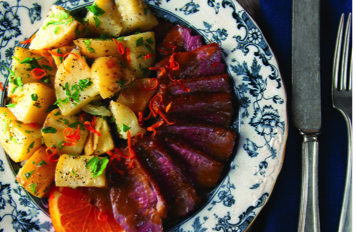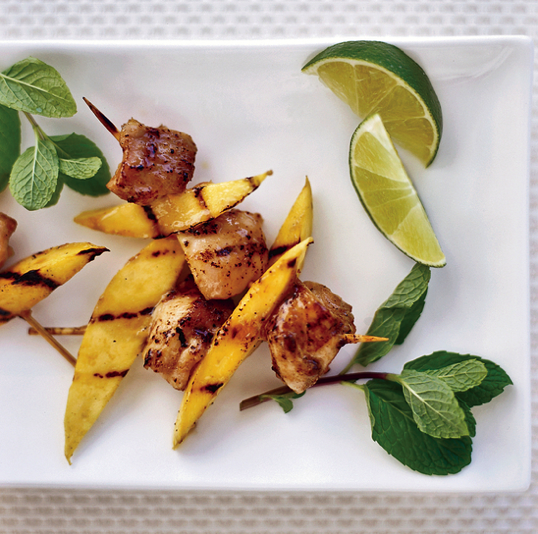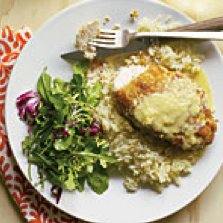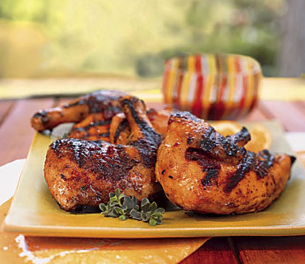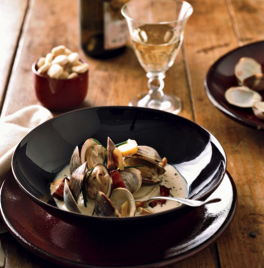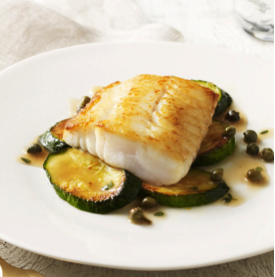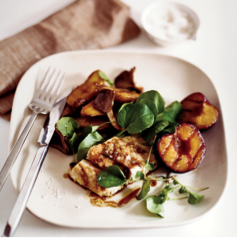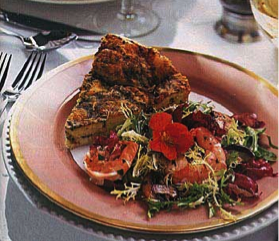Entrée Pairings
Our 2014 Estate Viognier with its delicate nectarine, white flower, guava, pear and citrus aromas and flavors and balanced acidity is extremely food-friendly making it a great pair for a number of different dishes including pork, veal, duck, chicken, crab, scallops, clams, mussels as well as numerous kinds of fish (including sushi) and select vegetable dishes. It also pairs very well with a number of different soft and hard cheeses.
Fruits and fruit based sauces provide natural complements to the wine. We suggest citrus (orange, lemon and tangerine) and stone fruit such as plums, nectarines and pears – for pork, duck and chicken dishes.
Due to its natural sweetness, our Viognier works well with a number of spices and sauces such as saffron, curry, and chipotle making it an excellent match for spicy Chinese, Indian, Mexican and Thai dishes.
We encourage you to experiment with differing meat, vegetable, fruit and spice combinations. We invite you to check out some of our favorite pairings on the following pages.
- Recipes
- Pan-Seared Pork Tenderloin with Rhubarb Compote
- Roasted Pork Loin with Poached Plums
- Duck Bigarade
- Chicken with Red Curry-Peanut Glaze
- Macadamia Chicken with Orange-Ginger Sauce and Coconut Pilaf
- Chicken with Tangerine, Honey, and Chipotle Glaze
- Oven-Roasted Dungeness Crab
- Bay Scallops with Polenta, Wild Mushrooms, Sherry, and Parsley Bread Crumbs
- Viognier-Steamed Clams with Bacon and Parsnips
- Salmon in Saffron Mussel Sauce
- Vinegar-Poached Sturgeon with Thyme-Butter Sauce
- Grilled Striped Bass with Plums and Potato-Mushroom Papillotes
- Roasted Pork Loin with Poached Plums
- Pan-Seared Pork Tenderloin with Rhubarb Compote
- Chive and Brie Strata
Click the tabs to the left to view our Recommended Entrée Pairings
- Pan-Seared Pork Tenderloin with Rhubarb Compote
- Roasted Pork Loin with Poached Plums
- Duck Bigarade
- Chicken with Red Curry-Peanut Glaze
- Macadamia Chicken with Orange-Ginger Sauce and Coconut Pilaf
- Chicken with Tangerine, Honey, and Chipotle Glaze
- Oven-Roasted Dungeness Crab
- Bay Scallops with Polenta, Wild Mushrooms, Sherry, and Parsley Bread Crumbs
- Viognier-Steamed Clams with Bacon and Parsnips
- Salmon in Saffron Mussel Sauce
- Grilled Striped Bass with Plums and Potato-Mushroom Papillotes
- Vinegar-Poached Sturgeon with Thyme-Butter Sauce
- Chive and Brie Strata
- Cheese Pairings
Pan-Seared Pork Tenderloin with Rhubarb Compote
BON APPÉTIT APRIL 2005
Makes 6 servings
Ingredients
- 6 tablespoons olive oil, divided
- 1 1/2 tablespoons ground black pepper
- 1 tablespoon salt
2 teaspoons dried rubbed sage - 2 teaspoons fennel seeds, ground in spice mill or in mortar with pestle
- 2 1/2 pounds pork tenderloins (about 2 large or 3 medium), trimmed of at and sinew
- 2 tablespoons chopped fresh parsley
- Fresh sage sprigs
- Rhubarb Compote
Preparation
Mix 3 tablespoons olive oil, ground black pepper, salt, dried sage, and ground fennel in small bowl. Rub oil mixture all over pork tenderloins; place in large baking dish and let stand 20 minutes.
Heat remaining 3 tablespoons oil in large nonstick skillet over medium-high heat. Add pork and cook until browned on all sides, about 6 minutes. Reduce heat to medium; cover and cook until instant-read thermometer inserted into center of pork registers 150°F, turning pork occasionally, about 8 minutes longer for medium tenderloins and 10 minutes for large.
Transfer pork to cutting board; let rest 5 minutes. Cut pork crosswise into 1/2-inch-thick slices; arrange on platter. Sprinkle with parsley; garnish with sage sprigs. Serve with Rhubarb Compote.
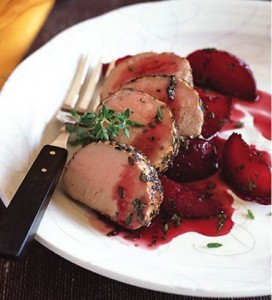
Roasted Pork Loin with Poached Plums
MIKE DAVIS BON APPÉTIT SEPTEMBER 2007 26 BRIX
Makes 6 servings
Ingredients
- Plums
- 6 sweet firm red or black plums (such as Burgundies, Satsumas,
or El Dorados; about 2 pounds), quartered, pitted - 2 cups Landa Vineyards Viognier
- 1 cup Landa Vineyards Syrah
- 2 whole star anise*
- cinnamon stick
- 1/4 cup plus 1 1/4 teaspoons sugar, divided
- 2 cups low-salt chicken broth
- 5 fresh thyme sprigs plus 1 teaspoon finely chopped thyme, divided
- 2 tablespoons chopped shallot
- Pork
- 2 1 1/4-pound pork tenderloins
- 3 tablespoons olive oil, divided
- 2 teaspoons chopped fresh thyme
- 2 garlic cloves, minced
- Chopped fresh chives
Preparation
Plums
Combine first 5 ingredients and 1/4 cup sugar in heavy large saucepan; bring to boil, stirring until sugar dissolves. Reduce heat; simmer until plums are tender, about 20 minutes. Transfer plums to platter. Strain wine mixture.
Return strained liquid to same saucepan. Add broth, thyme sprigs, and shallot. Boil until mixture is reduced to 1 cup, about 25 minutes. Strain sauce; stir in 1 1/4 teaspoons sugar and chopped thyme. Season with salt and pepper.
DO AHEAD: Can be made 1 day ahead. Cover plums and sauce separately; chill. Bring plums to room temperature; rewarm sauce over medium heat.
Pork
Preheat oven to 400°F. Brush pork with 1 tablespoon oil; sprinkle with thyme, garlic, salt, and pepper. Heat remaining 2 tablespoons oil in large ovenproof skillet over medium-high heat. Add pork and cook until brown on all sides, turning often, about 5 minutes. Transfer skillet to oven, and roast pork until thermometer inserted into center registers 140F, about 20 minutes. Remove skillet from oven and let pork stand 10 minutes. Cut pork crosswise into 1/2-inch-thick slices. Serve with poached plums and sauce. Sprinkle with chopped chives.
*Available in the spice section of some supermarkets and at specialty foods stores and Asian
Duck Bigarade
This is a modern rendition of a nineteenth-century recipe that ultimately became the legendary canard a l’orange, though it bears little resemblance to the gloppy 1960s version of duck a l’orange served in this country. This is much lighter and just a little bitter. The sauce was originally made with sour Seville oranges (bigarade is the Provençal term for these sour citrus), and if you can find them, by all means use them. Citrus and waterfowl are a perfect pair, and they both happen to be in season at the same time. Any skin-on duck breasts will work with this recipe, but I prefer Muscovy or large wild duck breasts.
Serve this dish with roasted or mashed potatoes, polenta, or a wild rice pilaf. A soft white wine is a good choice here, such as a Viognier, a Roussanne, or an oaky Chardonnay.
Makes 4 servings
INGREDIENTS
1 1/2 to 2 pounds duck breasts
Kosher salt
1 tablespoon all-purpose flour
1 cup Basic Duck Stock or chicken stock
Juice of 1 orange, preferably Seville (1/2 cup)
1 shot glass Grand Marnier or other orange liqueur, optional
1 tablespoon cider vinegar or sherry vinegar
1 teaspoon sugar
Grated zest of 1 orange
1/2 sweet orange, quartered and thinly sliced
PREPARATION
Remove the duck breasts from the refrigerator, salt them well, and set them aside at room temperature for 30 minutes.
Pan sear the duck breasts. You may have to do this in batches. When the breasts are cooked, set them aside skin side up on a cutting board and let them rest, tented with aluminum foil, while you make the sauce.
To make the sauce, pour off all but about 2 tablespoons of the fat from the pan and place the pan over medium heat. Sprinkle the flour into the pan and stir to combine and make a roux. Let it cook, stirring occasionally, for 4 to 5 minutes, until it is the color of coffee with cream.
Add a pinch of salt and stir to combine, then slowly stir in the stock, orange juice, liqueur, and vinegar. Everything will spatter at first, but it will calm down. Add any accumulated juices from the duck to the sauce. Let this boil down until it is a little thinner than the consistency of Thanksgiving gravy. Add the sugar, then taste and adjust with salt. If you want a more refined sauce, pour it through a fine-mesh sieve into a bowl.
To serve, slice the breasts. Spoon some sauce on each plate and top with breast slices. Garnish with the orange zest and orange slices.
Chicken with Red Curry-Peanut Glaze
Makes 4 Servings
Ingredients
1 large mango, peeled and cut into 2-inch squares, about 1/4 inch thick
1 1/2 pounds skinless, boneless chicken thighs, cut into 1-inch pieces
1 1/2 cups Red Curry-Peanut Sauce
Salt and freshly ground pepper
Vegetable oil, for brushing
Lime wedges, for serving
Instructions
Light a grill. In a bowl, toss the mango with the chicken and 3 tablespoons of the peanut sauce and season lightly with salt and pepper. Loosely thread the mango and chicken onto 8 skewers, alternating the pieces. Brush the skewers with oil and grill over high heat, turning occasionally, until the chicken is lightly charred in spots and nearly cooked through, 8 to 10 minutes. Brush 2 tablespoons of the peanut sauce on the skewers and grill, turning, until lightly browned, about 2 minutes. If the sauce becomes too thick to brush, thin it slightly with water. Serve the chicken-and-mango skewers with lime wedges and pass the remaining peanut sauce at the table.
SUGGESTED PAIRING
Full-bodied, spicy Viognier.
Macadamia Chicken
Perfect pairings for Viognier
With floral aromas, sweet-seeming fruit flavors, and rich textures, Viognier is made for bold, exotic dishes. It’s also great with cheeses and nuts. Some favorite pairings:
Sweet: shellfish Scallops, lobster, crab, and shrimp
Aromatic seasonings: Cinnamon, cardamom, coriander, ginger (in Moroccan tagines, for instance, as well as mild Indian curries and Caribbean dishes)
Nuts: Cashews, macadamias
Soft and semisoft cheeses: Fresh chèvre, gruyère, aged gouda, and double and triple creams like Cowgirl Creamery’s Mt. Tam or French brie
Macadamia Chicken with Orange-Ginger Sauce and Coconut Pilaf
We’ve layered this dish with tropical flavors to match Viognier’s perfume and bright citrus and stone-fruit flavors.
Macadamia Chicken with Orange-Ginger Sauce and Coconut Pilaf
Time: About 1 hour. We’ve layered this dish with tropical flavors to match Viognier’s perfume and bright citrus and stone-fruit flavors.
Makes 4 Servings
Ingredients
1 cup all-purpose flour
1 cup coconut milk
1 cup finely chopped roasted, salted macadamia nuts* (about 4 oz.)
1 cup panko (Japanese bread crumbs) or other fine dried bread crumbs
4 boned, skinned chicken breast halves (each 6 to 7 oz.)
Kosher salt
freshly ground black pepper
About 2 tbsp. butter
About 2 tbsp. olive oil
1 cup chopped shallots
1 1/2 tablespoons chopped ginger
1 1/2 tablespoons chopped garlic
1 cup reduced-sodium chicken broth
1/2 cup Viognier or other dry white wine
1/2 cup freshly squeezed orange juice* (from about 2 oranges)
Coconut Pilaf
Preparation
1. Preheat oven to 375°. Put flour and coconut milk in separate wide, shallow bowls. In another bowl, mix nuts and panko. Rinse chicken and pat dry. Sprinkle all over with salt and pepper.
2. Put 2 tbsp. butter and 2 tbsp. olive oil in a large frying pan over medium heat. Dredge chicken in flour, shaking off excess; dip into coconut milk, letting excess drip off; then press into nut mixture to coat on all sides. Reserve coconut milk. Lay chicken in frying pan in a single layer and cook until golden brown on the bottom, 3 to 4 minutes. With a spatula, turn pieces (taking care not to break off nut coating) and brown on the other side, 2 to 3 minutes longer. Transfer chicken to a baking pan and bake until no longer pink in center of thickest part (cut to test), 15 to 20 minutes.
3. Meanwhile, wipe any scorched nuts from pan with a paper towel. If pan is dry, add 1 tbsp. each butter and olive oil, then shallots, ginger, and garlic. Cook over medium heat, stirring often, until beginning to brown, about 5 minutes. Pour in broth, wine, and orange juice. Boil until liquid is reduced by about half, 8 to 10 minutes.
4. Pour mixture into a blender and, holding lid down tightly with a towel, whirl until very smooth. Return sauce to frying pan and add 1/4 cup reserved coconut milk (discard remainder) and salt and pepper to taste; stir over low heat until hot, then pour into a small bowl.
5. Spoon Coconut Pilaf onto plates, top with chicken, and serve with sauce.
*Chop the nuts by pulsing briefly in a food processor. Finely shred the peel from the oranges and save it for the pilaf.
Note: Nutritional analysis is per serving with 2 tbsp. sauce.
Nutritional Information
Amount per serving
Calories 689 Caloriesfromfat 51 % Protein 50 g Fat 39 g Satfat 12 g Carbohydrate 33 g Fiber 1.2 g Sodium 408 mg Cholesterol 119 mg
Chicken with Tangerine, Honey, and Chipotle Glaze
BY TED READER BON APPÉTIT JULY 2005
Makes 4 servings
Ingredients
Glaze
2 cups fresh tangerine juice
5 tablespoons honey
1/4 cup soy sauce
2 tablespoons finely grated tangerine peel or orange peel
2 teaspoons minced canned chipotle chiles in adobo sauce*
Chicken
1 cup fresh tangerine juice or orange juice
1/3 cup chopped fresh parsley
1/3 cup chopped fresh cilantro
3 tablespoons chopped fresh thyme
3 tablespoons minced peeled fresh ginger
3 tablespoons unseasoned rice vinegar
2 tablespoons olive oil
2 tablespoons finely grated tangerine peel or orange peel
1 teaspoon coarse kosher salt
1 2 3/4- to 3-pound chicken, quartered, backbone removed
Nonstick vegetable oil spray
Preparation
For glaze
Boil juice, honey, and soy sauce in heavy medium saucepan until reduced to 2/3 cup, about 20 minutes. Mix in grated peel and chipotle chiles.
For chicken
Whisk first 9 ingredients in 13x9x2-inch glass baking dish to blend. Add chicken; turn to coat with marinade. Cover; chill at least 2 hours and up to 1 day, turning occasionally.
Spray grill rack with nonstick spray and prepare barbecue (medium-low heat). Remove chicken from marinade; discard marinade. Sprinkle chicken lightly with salt. Grill chicken until cooked through, turning and repositioning occasionally for even cooking, about 20 minutes. Brush chicken all over with glaze; grill 2 minutes longer on each side. Transfer chicken to platter. Serve, passing remaining glaze separately.
*Chipotle chiles are dried, smoked jalapeños canned in a spicy tomato sauce, which is sometimes called adobo. They are available at some supermarkets, specialty foods stores, and Latin markets.
Oven-Roasted Dungeness Crab
BON APPÉTIT FEBRUARY 2005
Makes 2 servings
Ingredients
1/4 cup (1/2 stick) butter
1/4 cup olive oil
2 tablespoons minced garlic
1 tablespoon minced shallot
1 1/2 teaspoons dried crushed red pepper
2 large Dungeness crabs, cooked, cleaned, and cracked (about 4 1/4 pounds)
2 tablespoons chopped fresh thyme, divided
2 tablespoons chopped fresh parsley, divided
1/2 cup blood orange juice or regular orange juice
1 teaspoon finely grated blood orange peel or regular orange peel
Preparation
Preheat oven to 500°F. Melt butter with oil in heavy large ovenproof skillet over medium-high heat. Stir in garlic, shallot, and dried crushed red pepper. Add crabs; sprinkle with salt and pepper. Sprinkle 1 tablespoon chopped thyme and 1 tablespoon chopped parsley over crabs. Stir to combine. Place skillet in oven and roast crabs until heated through, stirring once, about 12 minutes.
Using tongs, transfer crabs to platter. Add orange juice and peel to same skillet; boil until sauce is reduced by about half, about 5 minutes. Spoon sauce over crabs. Sprinkle with remaining 1 tablespoon thyme and 1 tablespoon parsley and serve.
Dungeness Crab
These large crabs are prized for their sweet, tender meat. They’re named for Dungeness, Washington, where they were first harvested commercially, but they are caught in the Pacific Ocean all the way from Alaska to Mexico.
Bay Scallops with Polenta, Wild Mushrooms, Sherry, and Parsley Bread Crumbs
BON APPÉTIT FEBRUARY 2004
Makes 6 servings
Ingredients
1 cup fresh breadcrumbs from French bread with crust
2 tablespoons extra-virgin olive oil
2 tablespoons chopped fresh parsley
9 tablespoons unsalted butter, divided
12 ounces fresh chanterelle mushrooms or other fresh wild mushrooms (such as oyster, stemmed shiitake, or crimini, quartered if large)
2 1/2 teaspoons chopped fresh thyme
1 cup chopped green onions
1/2 cup amontillado Sherry
1/4 cup low-salt chicken broth
1/4 cup whipping cream
4 cups (or more) water
1 teaspoon salt
1 cup polenta
1 pound bay scallops
Preparation
Preheat oven to 350°F. Toss breadcrumbs with olive oil and parsley in medium bowl to blend. Spread onto rimmed baking sheet. Bake until golden and crunchy, stirring occasionally, about 15 minutes. (Can be made 1 day ahead. Cool completely. Store in airtight container at room temperature.)
Melt 4 tablespoons butter in heavy large skillet over medium-high heat. Add mushrooms and thyme. Sauté until mushrooms are tender, stirring occasionally, about 7 minutes. Add green onions; sauté 1 minute. Add Sherry; boil until slightly reduced, about 2 minutes. Add broth. Boil until reduced by half, about 3 minutes. Add cream; simmer until thickened, about 3 minutes. (Can be made 3 hours ahead. Cover and refrigerate.)
Bring 4 cups water and 1 teaspoon salt to boil in heavy medium saucepan. Gradually whisk in polenta. Reduce heat to medium-low. Cook polenta until tender, adding more water as needed if too thick, and whisking frequently, about 20 minutes. Stir in 3 tablespoons butter. Season with salt and pepper. Cover to keep warm.
Reheat mushroom mixture. Melt 2 tablespoons butter in another large skillet over high heat. Add scallops and sauté until just translucent in center, about 1 minute. Stir scallops and juices into mushrooms. Season with salt and pepper.
Divide polenta among 6 plates. Spoon scallop mixture over polenta, sprinkle breadcrumbs over, and serve.
Viognier-Steamed Clams with Bacon and Parsnips
Chef Dean Maupin thinks most things taste better with smoky bacon. These bacon-garnished briny clams, steamed in Virginia’s fruity and floral Viognier, are such a big hit that he serves them regularly during the cooler spring and fall months. That’s when the clams he likes from Willis Wharf, a small fishing town on the Eastern Shore of Virginia, are best. Try serving them with the wine they’re steamed in.
Makes 4 Servings
Ingredients
1 pound small parsnips, peeled
1/4 cup extra-virgin olive oil, plus more for brushing
Salt and freshly ground pepper
6 ounces thickly sliced bacon, cut crosswise into 1/2-inch strips
1 1/2 cups Viognier
2 tablespoons unsalted butter
1 shallot, minced
4 dozen littleneck clams, scrubbed and rinsed
1 cup heavy cream
2 tablespoons snipped chives
Oyster crackers, for garnish
Instructions
Preheat the oven to 350°. On a baking sheet, brush the parsnips with olive oil and season with salt and pepper. Roast the parsnips, turning once or twice, until tender, about 40 minutes. Let cool slightly, then quarter the parsnips lengthwise and slice them 1/4 inch thick.
Meanwhile, in a large, deep skillet, cook the bacon over moderately high heat until well browned and crisp, about 6 minutes. Drain the bacon strips on paper towels; wipe out the skillet.
In the skillet, bring the Viognier to a boil with the butter and shallot. Add the clams, cover and cook over high heat until they open, 6 to 8 minutes. Using a slotted spoon, transfer the clams to a large bowl.
Pour the clam broth into a glass measuring cup. Rinse out the skillet. Slowly pour the clam broth back into the skillet, stopping before you reach the grit at the bottom. Add the cream and boil until the liquid has reduced by half, about 8 minutes. If the cream sauce separates, transfer to a blender and puree until smooth, then return it to the skillet.
Add the roasted parsnips, bacon, chives and the cooked clams in their shells to the skillet. Season generously with pepper, cover and bring to a boil. Spoon into shallow bowls, sprinkle with oyster crackers and serve immediately.
SERVE WITH
White Cheddar and Scallion Muffins
SUGGESTED PAIRING
Viognier
Salmon in Saffron Mussel Sauce
BON APPÉTIT MARCH 2002
Makes 4 servings
Ingredients
1 pound mussels, scrubbed, debearded
1/2 cup dry white wine
1/2 teaspoon saffron threads, crushed
3/4 cup (about) whipping cream
1/2 cup canned crushed tomatoes with added puree
1 garlic clove, minced
1 bay leaf
1/8 teaspoon cayenne pepper
1 tablespoon olive oil
4 8-ounce skinless salmon fillets
1/2 teaspoon fresh lemon juice
Preparation
Combine mussels and wine in large saucepan over medium-high heat. Cover and cook until mussels begin to open, stirring occasionally, about 4 minutes. Using slotted spoon, transfer mussels to large bowl (discard any mussels that do not open). Pour liquid from saucepan into 2-cup measuring cup. Stir in saffron. Let cooking liquid stand 15 minutes.
Add enough cream to cooking liquid to measure 1 1/3 cups. Transfer to large saucepan. Stir in tomatoes, garlic, bay leaf, and cayenne. Simmer over medium heat until sauce thickens slightly, about 5 minutes. Season with salt and pepper. (Can be made 4 hours ahead. Cover and chill mussels and sauce separately.)
Heat oil in large nonstick skillet over high heat. Add salmon, rounded side down. Cook until bottom is golden, about 3 minutes. Turn salmon over. Reduce heat to low; cover and cook until salmon is opaque in center, about 4 minutes longer. Remove from heat. Leave covered to keep warm.
Bring sauce in large saucepan to simmer over low heat. Add mussels in shells; stir until heated through, about 2 minutes. Stir in lemon juice.
Place 1 salmon fillet on each of 4 plates. Divide mussels among plates. Spoon sauce over salmon and mussels.
Vinegar-Poached Sturgeon with Thyme-Butter Sauce
Makes 4 Servings
Ingredients
4 medium zucchini (1 1/2 pounds), sliced crosswise 1/2 inch thick
Salt
2 tablespoons unsalted butter, softened
1 teaspoon chopped thyme
Freshly ground pepper
3 tablespoons extra-virgin olive oil
Four 6-ounce skinless farmed sturgeon or wild Pacific halibut fillets
3 tablespoons homemade red wine vinegar
3/4 cup water
1 medium shallot, thinly sliced
3 tablespoons capers, drained and rinsed
Bouquet garni made with 2 parsley sprigs, 1 bay leaf and the leafy top of 1 celery rib, tied with kitchen string
Instructions
Preheat the oven to 375°. On a large rimmed baking sheet, sprinkle the zucchini slices with salt. Arrange them in an even layer and let stand for 1 hour. In a small bowl, blend the butter with the thyme and season with salt and pepper.
Rinse the zucchini slices and pat dry; wipe off the baking sheet. Return the zucchini to the baking sheet and toss with 2 tablespoons of the olive oil. Spread the slices in an even layer and bake until golden brown on the bottom, about 30 minutes. Transfer the zucchini to a platter.
Sprinkle the sturgeon with 1 tablespoon of the vinegar and refrigerate for 10 minutes. In a large, heavy skillet, combine the remaining 2 tablespoons of vinegar with the water, bouquet garni and shallot and bring to a boil. Season the poaching liquid lightly with salt and pepper and add the sturgeon fillets. Cover tightly and simmer over low heat, turning once, until the fish is barely cooked through, about 8 minutes. Transfer the sturgeon to a large plate. Strain the poaching liquid into a bowl.
Wipe out the skillet and set it over high heat. Add the remaining 1 tablespoon of olive oil and heat until shimmering. Add the sturgeon fillets, boned side down, and cook until golden brown on the bottom, about 2 minutes. Turn and cook for 1 minute longer. Set the sturgeon on the zucchini and cover with foil to keep warm.
Add the strained poaching liquid to the skillet and boil over high heat until reduced to 1/3 cup, about 5 minutes. Stir in the capers and remove from the heat. Swirl in the thyme butter and season the sauce with salt and pepper. Transfer the sturgeon and zucchini to plates, spoon the sauce on top and serve.
Grilled Striped Bass with Plums and Potato-Mushroom Papillotes
The Good News Cyril Renaud first made this fish dish in winter with oranges and liked it so much he adapted it for the warm months, using plums instead. Almost everything about this recipe helps make it both delicious and healthy. Grilling the plums and fish turns them nicely smoky with almost no added fat. And roasting vegetables en papillote (in a paper or foil pouch) intensifies their taste; more flavor comes from a little tamari.
Makes 4 Servings
Ingredients
1 pound fingerling potatoes, scrubbed
1/2 pound hen-of-the-woods or oyster mushrooms, thickly sliced lengthwise
1 tablespoon plus 1 teaspoon tamari
1 tablespoon plus 1 teaspoon balsamic vinegar
3 tablespoons extra-virgin olive oil
Salt and freshly ground pepper
Four 6-ounce striped bass fillets, skinned
2 teaspoons chopped rosemary
4 round purple plums, halved and pitted
Watercress sprigs, for garnish
Instructions
Light a grill. Preheat the oven to 500°. In a medium saucepan of boiling, salted water, cook the potatoes until tender, about 10 minutes. Drain and let cool. Peel the potatoes and halve them lengthwise.
Tear off four 20-by-14-inch sheets of parchment or foil. Spread equal amounts of potatoes and mushrooms on half of each sheet. In a small bowl, mix the tamari with the vinegar and 1 tablespoon of olive oil. Drizzle over the potatoes and mushrooms and season with salt and pepper. Fold the sheets over the vegetables and crimp to seal, if using parchment; if using foil, fold in the edges to seal the packages. Transfer the papillotes to 2 baking sheets and bake for about 15 minutes, or until sizzling.
Drizzle the bass fillets with 1 1/2 tablespoons of the olive oil, sprinkle with the rosemary and season with salt and pepper. Drizzle the plums with the remaining 1/2 tablespoon of olive oil. Grill the bass over high heat until nicely charred and just cooked, 3 to 4 minutes per side. Grill the plums, cut side down, until lightly charred, about 2 minutes per side.
Transfer the bass fillets and plums to plates. Set a papillote on each plate and open it, pouring out the potatoes, mushrooms and any juices. Watch out for the hot steam. Serve garnished with watercress.
MAKE AHEAD
The cooked, peeled potatoes can be refrigerated overnight. Bring to room temperature before using.
NOTES
One Serving 401 cal, 16 gm fat, 2.5 gm sat fat, 30 gm carb, 5 gm fiber.
Roasted Pork Loin with Poached Plums
MIKE DAVIS BON APPÉTIT SEPTEMBER 2007 26BRIX IN WALLA WALLA, WASHINGTON
Makes 6 servings
Ingredients
Plums
6 sweet firm red or black plums (such as Burgundies, Satsumas, or El Dorados; about 2 pounds), quartered, pitted
2 cups Pinot Gris or Viognier
1 cup dry red wine
2 whole star anise*
cinnamon stick
1/4 cup plus 1 1/4 teaspoons sugar, divided
2 cups low-salt chicken broth
5 fresh thyme sprigs plus 1 teaspoon finely chopped thyme, divided
2 tablespoons chopped shallot
Pork
2 1 1/4-pound pork tenderloins
3 tablespoons olive oil, divided
2 teaspoons chopped fresh thyme
2 garlic cloves, minced
Chopped fresh chives
Preparation
For Plums
Combine first 5 ingredients and 1/4 cup sugar in heavy large saucepan; bring to boil, stirring until sugar dissolves. Reduce heat; simmer until plums are tender, about 20 minutes. Transfer plums to platter. Strain wine mixture.
Return strained liquid to same saucepan. Add broth, thyme sprigs, and shallot. Boil until mixture is reduced to 1 cup, about 25 minutes. Strain sauce; stir in 1 1/4 teaspoons sugar and chopped thyme. Season with salt and pepper.
DO AHEAD:Can be made 1 day ahead. Cover plums and sauce separately; chill. Bring plums to room temperature; rewarm sauce over medium heat.
For Pork
Preheat oven to 400°F. Brush pork with 1 tablespoon oil; sprinkle with thyme, garlic, salt, and pepper. Heat remaining 2 tablespoons oil in large ovenproof skillet over medium-high heat. Add pork and cook until brown on all sides, turning often, about 5 minutes. Transfer skillet to oven, and roast pork until thermometer inserted into center registers 140F, about 20 minutes. Remove skillet from oven and let pork stand 10 minutes. Cut pork crosswise into 1/2-inch-thick slices. Serve with poached plums and sauce. Sprinkle with chopped chives.
*Available in the spice section of some supermarkets and at specialty foods stores and Asian markets.
Pan-Seared Pork Tenderloin with Rhubarb Compote
BON APPÉTIT APRIL 2005
Makes 6 servings
Ingredients
6 tablespoons olive oil, divided
1 1/2 tablespoons ground black pepper
1 tablespoon salt
2 teaspoons dried rubbed sage
2 teaspoons fennel seeds, ground in spice mill or in mortar with pestle
2 1/2 pounds pork tenderloins (about 2 large or 3 medium), trimmed of fat and sinew
2 tablespoons chopped fresh parsley
Fresh sage sprigs
Rhubarb Compote
Preparation
Mix 3 tablespoons olive oil, ground black pepper, salt, dried sage, and ground fennel in small bowl. Rub oil mixture all over pork tenderloins; place in large baking dish and let stand 20 minutes.
Heat remaining 3 tablespoons oil in large nonstick skillet over medium-high heat. Add pork and cook until browned on all sides, about 6 minutes. Reduce heat to medium; cover and cook until instant-read thermometer inserted into center of pork registers 150°F, turning pork occasionally, about 8 minutes longer for medium tenderloins and 10 minutes for large.
Transfer pork to cutting board; let rest 5 minutes. Cut pork crosswise into 1/2-inch-thick slices; arrange on platter. Sprinkle with parsley; garnish with sage sprigs. Serve with Rhubarb Compote.
Chive and Brie Strata
BON APPÉTIT JUNE 1999
Makes 10 to 12 servings
Ingredients
2 16-ounce loaves French bread, crusts trimmed, bread cut crosswise into 3/4-inch-thick slices
4 cups (or more) whole milk
10 large eggs
1 1/2 teaspoons salt
1 1/2 teaspoons ground black pepper
2 cups chopped fresh chives
18 ounces Brie cheese, chilled, rind trimmed, cheese cut into 1/2-inch pieces
8 tablespoons chopped fresh parsley
8 tablespoons chopped fresh tarragon
12 tablespoons grated Swiss cheese
2/3 cup grated Parmesan cheese
2 tablespoons (1/4 stick) butter
Preparation
Generously butter two 9-inch-diameter cake pans with 2-inch-high sides. Place bread in very large bowl. Pour 4 cups milk over. Let bread soak until soft, about 10 minutes. Squeeze bread slices over same bowl, extracting as much milk as possible. Transfer bread to medium bowl. Transfer milk from bowl to 2-cup measuring cup. If necessary, add more milk to equal 1 1/3 cups total. Return milk to very large bowl. Add eggs, 1 1/2 teaspoons salt and 1 1/2 teaspoons pepper to milk; whisk to blend well.
Arrange 1/4 of bread in each prepared pan. Sprinkle 1/2 cup chives over each. Sprinkle each with 1/4 of Brie cheese, then 2 tablespoons parsley and 2 tablespoons tarragon. Sprinkle 3 tablespoons Swiss cheese over each. Top each with half of remaining bread. Pour half of milk-egg mixture over each. Sprinkle 1/2 cup chives, 1/4 of Brie, 2 tablespoons parsley and 2 tablespoons tarragon over each. Sprinkle 3 tablespoons Swiss cheese and 1/3 cup Parmesan cheese over each. Dot each with 1 tablespoon butter. (Can be made 1 day ahead. Cover and chill.)
Preheat oven to 350°F. Bake puddings uncovered until puffed and deep golden brown on top, about 1 hour 10 minutes. Let cool 5 minutes. Cut into wedges and serve.
Wine and Cheese Pairing Guidelines
There are only two strict rules for pairing Wine and Cheese. The first rule is to match acidity. Tart wines should pair with sharper cheeses and mellow wines should pair with creamier cheeses. The second rule is to match power. Do not let a strong wine overpower a mild cheese, or vice versa. One additional tip, albeit not a rule, is to create a wine and cheese pairing by selecting products from the same region of the world. This brings in the element of terroir, which describes how foods get their qualities from the earth and the climate, and that a wine and a cheese from the same region should share complementary properties.
We at Landa Vineyards like to stick to the first two rules, but love to explore matching our wines with cheeses from all over the world. Our Viognier is a medium-to-full bodied white with wonderful citrus, light stone fruit and floral characteristics – ideal for pairing with semi-hard and medium-aged cheeses
The firmer texture and stronger flavors of these semi-hard cheeses need a wine that offers a balance between acidity, fruit, and tannin. Many, many cheeses fall into this category. Here are a few of our favorite variety: Edam, Young Cheddar, Monterey Jack, BelPaese, Young Gouda, Colby, Caciottona Capra, Caerphilly, Manchego (fresco and semicurado), Vermont Shepherd, Pyrenees Brebis, Emmental, Gruyère, Jarlsberg, Soft Blue Cheeses and Feta.
The stone fruits found (like peaches) in Viognier mouthwateringly cut through the savory flavors of Emmental, Jarlsberg or Gruyere. Softer cheeses like Tomme d’Alsace, Taleggio, Morbier, Brillat-Savarin, Livarot, Pave d’Affinois, and Pierre Robert are a also a delicious match with subtle characteristics of our Viognier.
Our Viognier is extremely versatile when it comes to cheese pairings. Its sweet spot is clearly in the semi-hard, medium-aged range, but can easily stretch into both younger and older and softer and harder selections. Here a few of our top picks for pairing with our Landa Vineyards Viognier. These cheeses can be found online at igourmet.com.
- Viognier Cheese Pairings
- Toma by Point Reyes
- Point Reyes Original Blue
- Humboldt Fog
- Livarot
- Bel Paese
- Marieke Young Raw Milk Gouda
- Artisan Raw-Milk Manchego
- Jarlsberg
- Frantal Emmental
- Thomasville Tomme
- Murcia al Vino
- Taleggio
- Brillat Savarin Affine
- Pierre Robert
- Pave d'Affinois
- Caerphilly
- Crowley Sharp
- Caciottona Capra al Fieno Perenzin
Click the tabs to the left to see our current Cheese Pairing Recommendations
- Toma by Point Reyes
- Point Reyes Original Blue
- Humboldt Fog by Cypress Grove Chevre
- Livarot
- Bel Paese
- Marieke Young Raw Milk Gouda
- Artisan Raw-Milk Manchego 3 Month by Dehesa
- Jarlsberg (R) Cheese
- Frantal Emmental
- Thomasville Tomme by Sweet Grass Dairy
- Murcia al Vino
- Taleggio
- Brillat Savarin Affine
- Pierre Robert
- Pave d’Affinois
- Caerphilly
- Crowley Sharp
- Caciottona Capra al Fieno Perenzin
Toma by Point Reyes
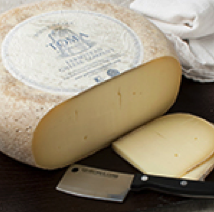
Toma has a creamy, buttery flavor with a grassy tang in the finish. Fromthe makers of the famous Point Reyes Blue, Toma is an all natural, pasteurized, semi-hard, table cheese with a natural rind. (incidentally, in Italian, toma means “cheese made by the farmer himself”). This cheese is a multiple-award winner and creates an interesting pairing with the citrus tang in our Viognier!
Point Reyes Original Blue
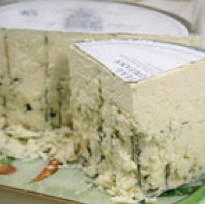
As Americans have developed a deeper appreciation for great cheese, a change in American cheese making has occurred. Across the country, small-scale dairy farmers and cheese makers are making wonderful cheeses to rival those of Europe. One of these cheeses is Humboldt Fog. With a central layer and outer covering of ash, this goat’s milk tome ripens with a soft, white interior. When cut, it is reminiscent of the early morning fog. Humboldt Fog is made by Cypress Grove Chevre, which is owned and operated by mother and daughter team, Mary Keehn and Malorie McCurdy, in Humboldt County, California, among the towering redwood trees. These amazing women have an enviable passion for their work that has been rewarded by national awards, reputation, and a steadily growing business. American farmstead cheeses often command a hefty price due to their limited production, but one bite will convince you that the luxury is worth the cost.
Humboldt Fog by Cypress Grove Chèvre
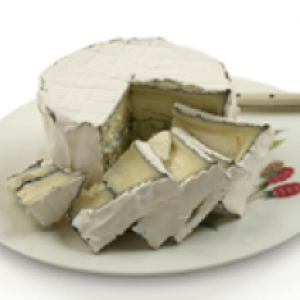
As Americans have developed a deeper appreciation for great cheese, a change in American cheese making has occurred. Across the country, small-scale dairy farmers and cheese makers are making wonderful cheeses to rival those of Europe. One of these cheeses is Humboldt Fog. With a central layer and outer covering of ash, this goat’s milk tome ripens with a soft, white interior. When cut, it is reminiscent of the early morning fog. Humboldt Fog is made by Cypress Grove Chevre, which is owned and operated by mother and daughter team, Mary Keehn and Malorie McCurdy, in Humboldt County, California, among the towering redwood trees. These amazing women have an enviable passion for their work that has been rewarded by national awards, reputation, and a steadily growing business. American farmstead cheeses often command a hefty price due to their limited production, but one bite will convince you that the luxury is worth the cost. This striking cheese comes in a 15-ounce mini-wheel with a charming paper wrapper.
Livarot
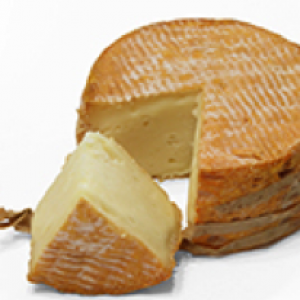
Named after a village in Normandy, Livarot is a very strong-smelling cheese. For those of us who can withstand the smell however, it is one of the world’s great eating cheeses with a smooth, ripe, slightly spicy flavor. Its rind is encircled with straps of paper that prevent the cheese from collapsing during maturing. The straps are reminiscent of a colonel’s stripes, giving the cheese its nickname “The Colonel”. A young, soft cheese that becomes runny at room temperature, Livarot is a true gourmet item in the French tradition and works well with the acidity of our Viognier.
Bel Paese
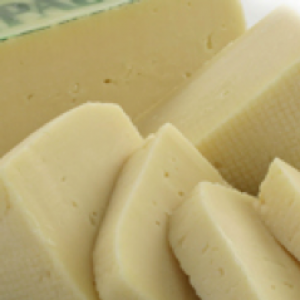
Invented in Lombardy in 1929 by the Galbani Cheese Company, Bel Paese (Italian for “beautiful country”) is now made in Wisconsin. Dante used the phrase “Bel Paese” to describe Italy, which inspired Galbani’s name for this Italian-style cheese. It is a semi-soft, uncooked, pressed pasteurized cow’s milk cheese with a wax rind. Made in small discs, it is a pale, creamy yellow, and has small holes within its texture. Bel Paese has a mild, buttery flavor, similar to mozzarella but with more body and tang. A versatile cheese, Bel Paese is suitable for cracker-snacks or as a dessert cheese. Bel Paese presents a savory partner for our Landa Vineyards Viognier.
Marieke Young Raw Milk Gouda
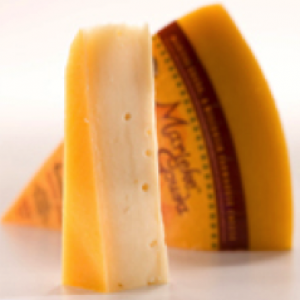
This young, 2-4 month raw milk Gouda is a real treat for lovers of Gouda with character. Expert, Licensed cheesemaker, Marieke Penterman and her team, handcraft traditional Dutch Goudas using the time-tested, Old World, cheesemaking methods Marieke brought with her when she emigrated from the Netherlands. Marieke transforms farmstead-fresh, raw, cow’s milk from her family farm into award-winning cheese, which is then carefully cured on imported Dutch pine planks in temperature and humidity-controlled aging cellars. This aged gouda has a nutty flavor and slightly crystalized texture with deep, nuanced flavors. Enjoy Marieke Young Gouda with apricot preserves, toasted almonds, and a robust Viognier. Rolf and Marieke Penterman are first generation Wisconsin dairy farmers having moved from the Netherlands to Wisconsin in 2002.
Marieke Gouda is their signature cheese made with an authentic Old World Gouda recipe. The equipment, cultures, herbs and spices are all imported from Holland. The rBGH free cows milk couldn’t be fresher, being piped directly from the first milking of the day directly into the processing vat. The curd is hand packed into 18-pound forms before going under the press. It is then brined for 60 hours. The wheels are then transferred to the special curing room and aged on Dutch pine planks which absorb the liquid as the cheese ages. For the first 14 days the cheese is turned (flipped over) daily to ensure that the butterfat is evenly distributed throughout the cheese. The wooden planks are also cleaned daily and turned to prevent molds. During this time the breathable coating is hand painted on the cheese. After the initial daily turning is complete the cheese is turned twice weekly for as long as it is in their facility. This multiple award winning cheese is a must-try for anyone interested in American Artisan cheeses and offers a flavorful companion for our Landa Vineyards Viognier.
Artisan Raw-Milk Manchego 3 Month by Dehesa
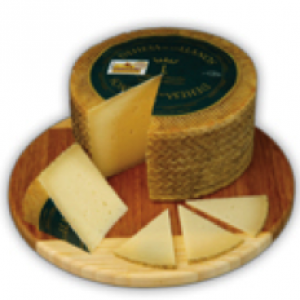
This Artisan Manchego Cheese D.O. is cured for a minimum of 3 months. Made with raw milk from the Manchega breed of sheep raised on the estate of the award winning Dehesa de Los Llanos. With an intense straw color, unique and uniform, the Semi Cured of Dehesa de Los Llanos is characterized by its intense flavor and aroma typical of a high quality cheese, slightly spicy, a flaky texture and great friability that makes the cheese crumble in your mouth, liberating all its flavor and inviting you to have more.
The natural rind of the Semi Cured is the first attractive feature of this great cheese, where the consumer can appreciate that no colorings or dyes foreign to the cheese have been added during its elaboration. With a soft straw color, unique and uniform, the Semi Cured cheese of Dehesa de Los Llanos is characterized by its mild flavor and aroma typical of a high quality semi cured cheese, a creamy texture and great friability that makes the cheese crumble in your mouth, liberating all its flavor and inviting you to have more.
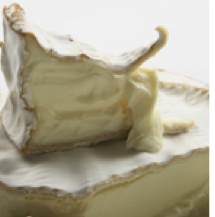
Brillat Savarin Affine

Humbolt Fog
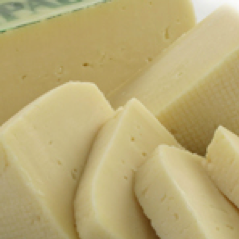
Bel Paese
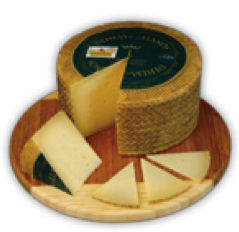
Manchego
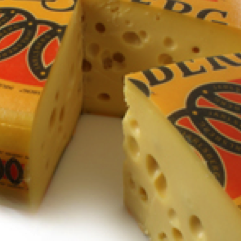
Jarlsberg
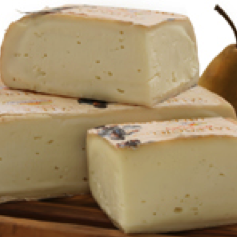
Taleggio

Caerphilly
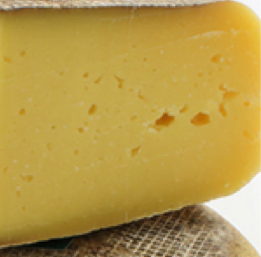
Thomasville Tomme
Jarlsberg
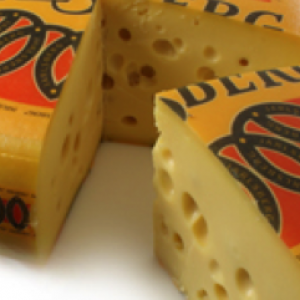
In Norway, dairy farmers take their cheesemaking very seriously. Jarlsberg Cheese is not made on small farms in rural communities, but rather is produced in large quantities through a multi-stage, high-tech manufacturing process. The special bacteria that gives it its famous wide-eyed holes and its sweet flavor is cultivated in a controlled environment, then added to the curd midway through the cheesemaking process. The result is a beautiful and delicious 20-pound wheel that defines the baby swiss category of cheeses. Jarlsberg Cheese was first produced in 1815 and has long since become Norway’s most famous cheese and a household name here in America.
Frantal Emmental
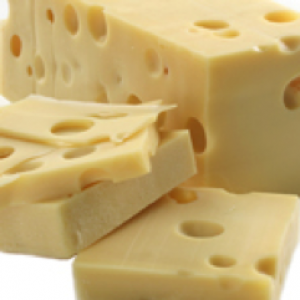
Most people assume the only real Emmental (more commonly referred to as “Swiss Cheese”) comes from Switzerland. Our French Emmental, however, proves to be every bit as worthy of the name. It comes from the heart of the French Alps near the chic ski resort of Chamonix. The freshest water in the world rushes down this region’s high mountains, through deep valleys and abundant rivers and feeds the French dairy farms that produce Emmental’s milk. Frantal Emmental is ripened to perfection in the traditional 180 pound wheels. They are turned weekly in the ripening chambers for a minimum of two months. It has a somewhat sweet, buttery taste that is slightly reminiscent of fresh nuts and has many round walnut-sized holes evenly distributed throughout. A result of a complex and difficult cheesemaking process, Frantal Emmental is worth the effort. Taste the difference!
Thomasville Tomme by Sweet Grass Dairy
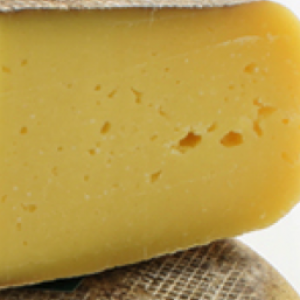
Sweet Grass Dairy of Thomasville, Georgia practices biologically sustainable, grass-based farming. Their Jersey cow and multi-breed goat herds are rotationally grazed and live their entire lives outside, roaming lush pastures and browsing the South Georgia woods. Their pastures are precisely managed, beginning with the gentle nurturing of the biological life in the soil. The high standard of operation at the farm provides the animals with healthy and clean lifestyles and provides an enjoyable work environment for the farm’s employees. The bottom line is that Sweet Grass Dairy’s animals are happy. Happy animals produce valuable, luscious milk, and rich milk makes the best cheese.
This cheese is named after Sweet Grass Dairy’s home town. When it is made, the cheese is put into molds while the curd is still very soft. This results in a smooth and creamy taste. We are impressed by its golden yellow color and mellow and buttery flavor characteristics.
The Thomasville Tomme can be used in a variety of applications. It melts well and can be used in anything from fondue to omelets. As a snack or part of the dessert course, it simply melts in your mouth. Pair it with a flavorful Viognier or Syrah and serve with ripe melons, thinly sliced prosciutto and sourdough bread.
1st Place winner at the 2002 American Cheese Society Awards!
Murcia al Vino
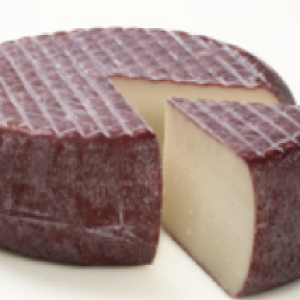
Similar to the Spanish wine cheese, Drunken Goat, this wine-bathed cheese is made from pasteurized goat’s milk in the Murcia region of Spain. This region has a rich variety of grasses, shrubs, and wild herbs on which the goat’s graze to give the cheese a distinctive taste and aroma. The unique feature of Murcia al Vino is that it is washed in red wine during ripening. The wine deeply tints the cheese, giving the rind its characteristic burgundy color and imparting a strong floral bouquet. Murcia al Vino is a real gem. It not only has a bold, delicious flavor, it has the intoxicating aroma of a good bottle of wine and works well with both our Viognier and Syrah.
Taleggio
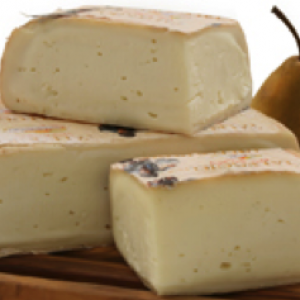
The softest, creamiest member of the famous Italian Stracchino cheeses, Taleggio was first made in the valley of the same name, located in the historic province of Bergamo. Taleggio made its debut in the international cheese markets after World War I, around the same time as its cousin Bel Paese. Its rough, rosy crust (inedible), pale yellow interior, and rich and buttery, fruity, slightly salty flavor are what give Taleggio its individuality. Taleggio’s soft, incredibly flavorful interior is creamy in texture and has a pungent aroma. Perfect paired with bold red wines like Sangiovese, melted into polenta, or just served with crusty bread. The cheese imparts the essence of the Italian countryside in such a demonstrative manner that you could swear you were sitting among the cows on a grassy hillside in Lombardy.
Brillat Savarin Affine
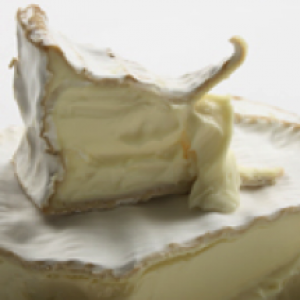
This decadent triple cream cheese should only be eaten with friends! It is one of the richest cheeses you will ever taste. Brillat Savarin is native to Normandy and is named after the man who is known today as, “The Father of Modern Cooking,” Jean Anthelme Brillat-Savarin. He is the author of the book, The Physiology of Taste, which is required reading for any food lover. This cheese is perfect for savory dessert and should be served with ripe, fresh fruit and crusty, French bread and of course, a nice bottle of Landa Viognier!
Pierre Robert
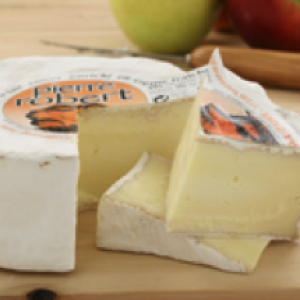
Similar to Brillat Savarin, but from farther south in France (the Champagne region), this triple-creme owes its name to two friends who created it in the 1970’s. The more famous of the two, Robert Rouzaire, founded the Rouzaire cheese manufacturing company. According to Pierre and Robert’s story, impatience played a major role in the development of this fresh cheese. Tired of waiting for the cheese to fully ripen, they consumed a wheel of it early in the cheese-making process, when the cheese was quite soft and still spreadable on the inside. They loved it and went on to perfect the recipe, adding creme fraiche before curing for extra creaminess. With a rich, buttery texture and a tangy aftertaste, this is one cheese you will definitely want to include on the cheese board and an awesome treat when paired with a a crisp Viognier.
Pave d’Affinois
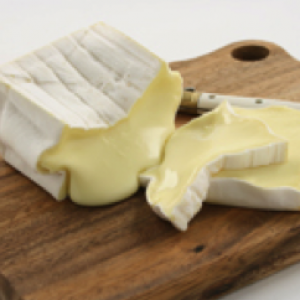
Pave d’Affinois is a simple, white-rinded cheese with a pleasing finish. Made in small, 5.3-ounce squares that are individually wrapped, this cheese is reminiscent of a Brie or a Camembert. It is perfect for those looking for something about the size of a Chaource with a slightly milder flavor. With its delicious richness, this double cream cheese provides an unforgettable tasting experience. It gets its character from the familiar flavor of a cow’s milk cheese with a slightly grassy finish.
Caerphilly
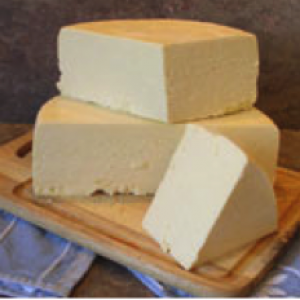
Caerphilly is an original Welsh cheese that is quite similar in texture to English Wensleydale. Caerphilly differentiates itself by having a higher moisture content than Wensleydale, giving it a more buttery and less crumbly consistency. A young, white, fresh-tasting cheese, Caerphilly has a pleasant, creamy flavor that goes well with a crisp Viognier.
Crowley Sharp
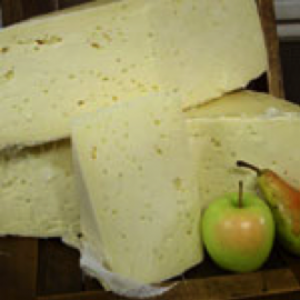
Crowley’s cheese making history began in Healdville, Vermont, in 1824. In 1882, Winfield Crowley built a small, 30 feet by 30 feet, three-story building. Crowley Cheese continues to be made in this factory. The entire production process is completely “human” powered. Only a few hundred pounds of cheese are made each day and the process is exactly the same as when the factory was established. There is no automatic stirring equipment or other devices.
Although similar to the English-style cheddars made by other Vermont producers, Crowley Cheese is an “American Original.” There are very few cheeses that originated in the United States. Most came with the various immigrant groups who settled our country. Similar to a cheddar and grouped in the cheddar family of cheeses, Crowley Cheese is officially designated by the FDA as a “Colby” even though it is not truly similar to industrial Colby and despite the fact that Crowley Cheese was made for decades before Colby cheese, named after Colby, Wisconsin, existed. Crowley Cheese is the only remaining original Vermont cheese.
Caciottona Capra al Fieno by Perenzin
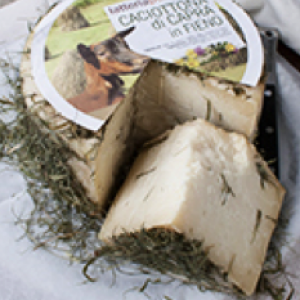
The Perenzin family has been making traditional cheeses for 4 generations. Their winning tradition began when they earned a gold medal at the Brussels “Salon des Arts Managers” in 1933, and the medals have kept on coming ever since. All of their cheeses are handcrafted and all production is supervised directly by Carlo Piccoli, a seasoned professional with twenty years of cheesemaking experience.
This cheese has a semi-hard, compact interior of pale straw yellow color, with evenly distributed eyes of uniform size. A maturing period of at least sixty days is required in order to obtain Caciottona’s soft and delicate flavor, suitable for slicing or chunking. The outside is coated with fresh hay grown near the cheese factory, giving the cheese a delicious grassy scent and unique sweet aroma.



